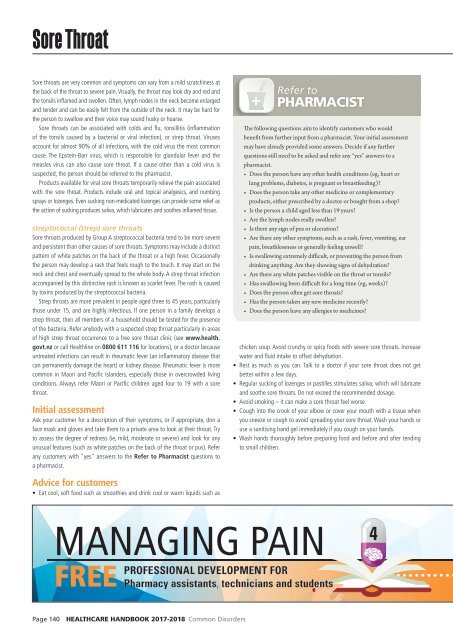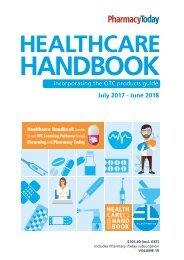2017 HCHB_digital
You also want an ePaper? Increase the reach of your titles
YUMPU automatically turns print PDFs into web optimized ePapers that Google loves.
Sore Throat<br />
Sore throats are very common and symptoms can vary from a mild scratchiness at<br />
the back of the throat to severe pain. Visually, the throat may look dry and red and<br />
the tonsils inflamed and swollen. Often, lymph nodes in the neck become enlarged<br />
and tender and can be easily felt from the outside of the neck. It may be hard for<br />
the person to swallow and their voice may sound husky or hoarse.<br />
Sore throats can be associated with colds and flu, tonsillitis (inflammation<br />
of the tonsils caused by a bacterial or viral infection), or strep throat. Viruses<br />
account for almost 90% of all infections, with the cold virus the most common<br />
cause. The Epstein-Barr virus, which is responsible for glandular fever and the<br />
measles virus can also cause sore throat. If a cause other than a cold virus is<br />
suspected, the person should be referred to the pharmacist.<br />
Products available for viral sore throats temporarily relieve the pain associated<br />
with the sore throat. Products include oral and topical analgesics, and numbing<br />
sprays or lozenges. Even sucking non-medicated lozenges can provide some relief as<br />
the action of sucking produces saliva, which lubricates and soothes inflamed tissue.<br />
streptococcal (strep) sore throats<br />
Sore throats produced by Group A streptococcal bacteria tend to be more severe<br />
and persistent than other causes of sore throats. Symptoms may include a distinct<br />
pattern of white patches on the back of the throat or a high fever. Occasionally<br />
the person may develop a rash that feels rough to the touch. It may start on the<br />
neck and chest and eventually spread to the whole body. A strep throat infection<br />
accompanied by this distinctive rash is known as scarlet fever. The rash is caused<br />
by toxins produced by the streptococcal bacteria.<br />
Strep throats are more prevalent in people aged three to 45 years, particularly<br />
those under 15, and are highly infectious. If one person in a family develops a<br />
strep throat, then all members of a household should be tested for the presence<br />
of the bacteria. Refer anybody with a suspected strep throat particularly in areas<br />
of high strep throat occurrence to a free sore throat clinic (see www.health.<br />
govt.nz or call Healthline on 0800 611 116 for locations), or a doctor because<br />
untreated infections can result in rheumatic fever (an inflammatory disease that<br />
can permanently damage the heart) or kidney disease. Rheumatic fever is more<br />
common in Maori and Pacific Islanders, especially those in overcrowded living<br />
conditions. Always refer Maori or Pacific children aged four to 19 with a sore<br />
throat.<br />
Initial assessment<br />
Ask your customer for a description of their symptoms, or if appropriate, don a<br />
face mask and gloves and take them to a private area to look at their throat. Try<br />
to assess the degree of redness (ie, mild, moderate or severe) and look for any<br />
unusual features (such as white patches on the back of the throat or pus). Refer<br />
any customers with "yes" answers to the Refer to Pharmacist questions to<br />
a pharmacist.<br />
Refer to<br />
PHARMACIST<br />
The following questions aim to identify customers who would<br />
benefit from further input from a pharmacist. Your initial assessment<br />
may have already provided some answers. Decide if any further<br />
questions still need to be asked and refer any “yes” answers to a<br />
pharmacist.<br />
• Does the person have any other health conditions (eg, heart or<br />
lung problems, diabetes, is pregnant or breastfeeding)?<br />
• Does the person take any other medicine or complementary<br />
products, either prescribed by a doctor or bought from a shop?<br />
• Is the person a child aged less than 19 years?<br />
• Are the lymph nodes really swollen?<br />
• Is there any sign of pus or ulceration?<br />
• Are there any other symptoms, such as a rash, fever, vomiting, ear<br />
pain, breathlessness or generally feeling unwell?<br />
• Is swallowing extremely difficult, or preventing the person from<br />
drinking anything. Are they showing signs of dehydration?<br />
• Are there any white patches visible on the throat or tonsils?<br />
• Has swallowing been difficult for a long time (eg, weeks)?<br />
• Does the person often get sore throats?<br />
• Has the person taken any new medicine recently?<br />
• Does the person have any allergies to medicines?<br />
chicken soup. Avoid crunchy or spicy foods with severe sore throats. Increase<br />
water and fluid intake to offset dehydration.<br />
• Rest as much as you can. Talk to a doctor if your sore throat does not get<br />
better within a few days.<br />
• Regular sucking of lozenges or pastilles stimulates saliva, which will lubricate<br />
and soothe sore throats. Do not exceed the recommended dosage.<br />
• Avoid smoking – it can make a sore throat feel worse.<br />
• Cough into the crook of your elbow or cover your mouth with a tissue when<br />
you sneeze or cough to avoid spreading your sore throat. Wash your hands or<br />
use a sanitising hand gel immediately if you cough on your hands.<br />
• Wash hands thoroughly before preparing food and before and after tending<br />
to small children.<br />
Advice for customers<br />
• Eat cool, soft food such as smoothies and drink cool or warm liquids such as<br />
MANAGING PAIN<br />
FREE<br />
PROFESSIONAL DEVELOPMENT FOR<br />
Pharmacy assistants, technicians and students<br />
4<br />
Page 140 HEALTHCARE HANDBOOK <strong>2017</strong>-2018 Common Disorders



